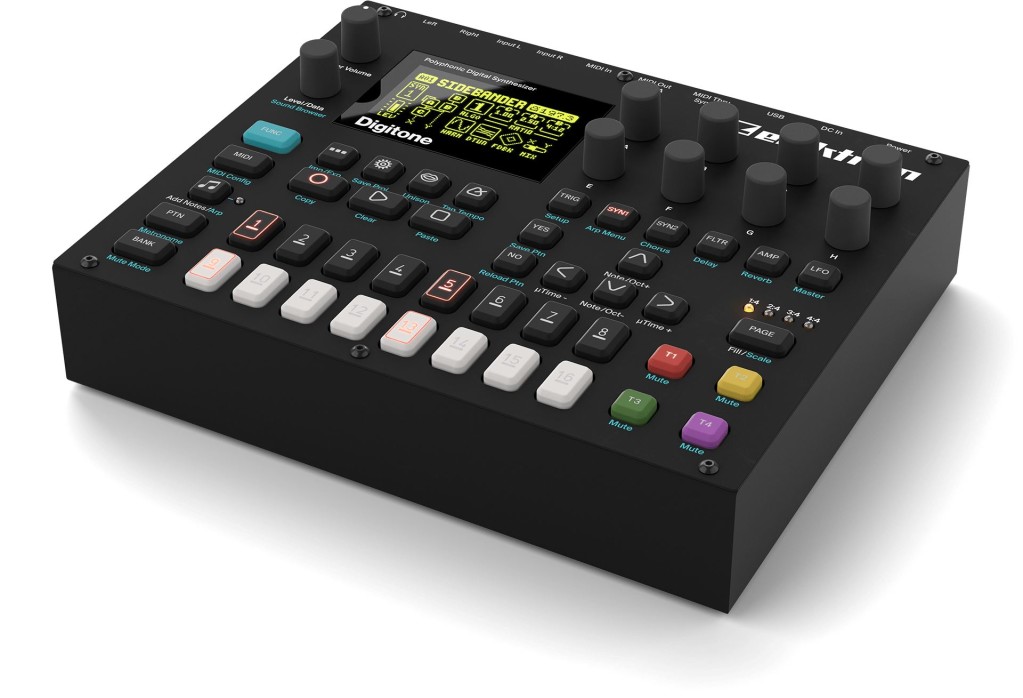Elektron have applied their cute-and-friendly formula from the Digitakt drum machine to a new synth called Digitone – and it’s FM.
Now, the phrase Elektron uses is “accessible” – the press release writes “powerful yet user-friendly take on FM synthesis.” But this isn’t just marketing speak; it seems they really have made an effort to make frequency modulation more playable.
Good electronic music instruments give users lots of stuff to touch, and the feeling that the full range of each knob, for instance, sounds good or at least plausible. That’s where the wonders of FM sort of break down when they hit making hardware. Frequency Modulation synthesis is based on a simple principle: modulating a waveform with another waveform in the same audio range. And the whole joy of this is suddenly breaking open surprising tones – covering ranges edgy, metallic, unstable, futuristic.
Or – with a tiny change in parameter – something totally unrelated. Or awful. Or silent. So, to avoid unpleasant surprises, hardware builders have tended to hide away that complexity. So, the mighty Yamaha DX7 has basically no controls – and as it popularized FM, also gave people the (mistaken) impression that it always had to sound like Yamaha’s presets.
Plus, while those sounds are great, sometimes they need softening. (Think of the difference between hearing a reed instrument, and hearing just the reed.)
For fans of FM synthesis, just as exciting as the Elektron news this week is the extensive interview with John Chowning (who’s a natural teacher, always a pleasure to listen to):
Elektronauts Talk: John Chowning
Don’t miss his bit about how he explains FM synthesis to a child – it’s really elegant. And Dr. Chowning picks up on the two things Elektron has done:
1. Set some limits so you get hands-on control over sound without getting lost – exploring space, but not throwing yourself out an airlock.
2. Putting the FM synthesis engine inside a more conventional subtractive synthesis architecture. (Basically – adding filters!)
As John describes those:
I noticed, in your instrument, that you put some boundaries on the possibilities so that one doesn’t end up in a daze without understanding how you got there, or end up in silence.
And regarding the architecture:
[Digitone] lets the user intuitively explore this re-formable, shapeable ball of stuff, then put that through the normal processes of synthesis.
So the thing to watch with the Digitone will be how well its presets and sound design work in practice. You’ve got a four-operator FM synth. That’s the architecture used by Robert Henke for Ableton’s Operator, precisely because it’s more manageable (and covers most of the sounds you want to create); adding operators adds a lot of complexity.
Then each voice (there’s 8-voice polyphony) adds filters: one multimode, one “base-width.” (Think they mean bandpass? I’ll ask.) And each voice comes with two assignable LFOs and overdrive to make things dirtier.
They’ve also added quite a lot in the effects section – sends for chorus, reverb, and delay, plus a master overdrive.
This being an Elektron box, integration of instrument and sequencer are key. And like the Digitakt, even this smaller box can be used to drive external gear. There are four synth tracks and four MIDI tracks, both, so the Digitakt is a bit like a mini Octatrack – it can be a hub for a live performance or synth rig.
With trig conditions (interactive events that can occur on each step) and track lengths and micro timings, you can make some fairly complex patterns. And whereas the DX7 and its ilk let you punch in a preset and then play it as-is forever until everyone got annoyed of the sound, Elektron bring parameter locks to make per-step transformations of your creations. So imagine all that sonic possibility of FM synthesis, changing as the sequence runs. We saw a peek of how much fun that is with KORG’s humble volca fm – now you get it on a deeper FM synth.
Worth investigating in a review – how much work is it to modify or program your own presets, how it works having parameters change with different presets, and how playable the whole thing is. But even though FM synthesis is a creation of the 1960s, having a playable, sequenced FM synth definitely stands out from the crowd of noisemakers at the moment. The new Elektron is available now, though currently listed as sold out. (Someone obviously likes the idea.)
$759 USD/779 EUR/£699 GBP.
https://www.elektron.se/products/digitone/
Specs:
Synth voice features:
8 voice polyphony (multitimbral)
Multiple FM algorithms
1 × multimode filter per voice
1 × base-width filter per voice
1 × overdrive per voice
2 × assignable LFO per voiceSequencer:
4 synth tracks
4 MIDI tracks
1 arpeggiator per track
Polyphonic sequencing
Individual track lengths
Parameter locks
Micro timing
Trig conditions
Sound per step changeSend & master effects
Panoramic Chorus send effect
Saturator Delay send effect
Supervoid Reverb send effect
Overdrive master effectHardware
128 × 64 pixel OLED screen
2 × 1/4” impedance balanced audio out jacks
2 × 1/4” audio in jacks
1 × 1/4” stereo headphone jack
48 kHz, 24-bit D/A and A/D converters
Hi-Speed USB 2.0 port
MIDI In/Out/Thru with DIN Sync outPhysical specification
Sturdy steel casing
Dimensions: W 215 × D 176 × H 63 mm (8.5” × 6.9” × 2.5”) (including knobs and feet)
Weight: approximately 1.49 kg (3.3 lbs)
100 × 100 mm VESA mounting holes. Use M4 screws with a max length of 7 mm.
And of course, yes, Overbridge (Elektron’s tech for helping integrate their external hardware with your software rig).
Also worth watching –

